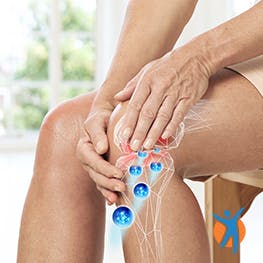Bad posture. We’ve all done it. Whether we’re popping a hip out to hold our favourite little kid, slouching on the couch in front of the tv, or hunched over our phone or computer, all of us practice bad posture at least some of the time, if not ...all of the time. At first, not standing up straight feels more comfortable, right? But here’s the thing. Stooped posture can be part of why your back hurts. Improving your posture can be a matter of just a few simple steps. Here are some tips for correcting it.
Some signs of bad posture you may be able to see, including rounded, sloped shoulders, a hunched neck, a pot belly or a tendency to jut your head forward. Others you can feel: back pain, body aches and pains, muscle fatigue or headache.
What is posture anyway?
When we were younger, we were often told to sit or stand up straight. In those days, this may have been mostly a matter of good decorum. However, good posture is not just a matter of good manners. It is much more than that.
Posture refers to the way in which your body is positioned when you are sitting, moving or standing. As well as being vital ...for our movement and comfort, having good posture means that muscles and ligaments are not working harder than they should.
Posture helps keep your body erect. It can also, to some degree, ensure proper breathing, muscle growth, and movement. Additionally, it can help alleviate some body pain. Poor posture can affect your health overall, and set you up for neck and shoulder strain, back pain and even joint damage. This is why practicing good posture is important.
There is an aesthetic aspect to good posture, as well. That hunched neck and potbelly may just go away once you stop slouching, and start sitting and standing up straight.
Back pain can be brought on by trauma - like from a sports-related injury or an accident – or an inherited condition like scoliosis. However, often, back pain can be due to normal wear and tear on the body that develops over the course of everyday activities. This is where posture plays a part in back pain.
Stooped posture – in other words, posture that does not provide proper support for your body – can cause the weight load on your back to be unevenly dispersed, thus pushing your back’s muscles, ligaments, and discs beyond their capacity, causing pain.
Sitting incorrectly at a makeshift home office desk can also put a lot of strain on movement muscles; leaning down hunched over a laptop uses groups of muscles that were designed for movement, rather than your postural muscles (as the name suggests) your core group of muscles which with little effort hold you together and upright!
Hunching while standing or sitting can cause your back and abdominal muscles to become strained as the weight of your body is improperly distributed. This can also reduce the blood supply to these muscles, leaving them stiff and sore over time. Likewise, working on your laptop or reading on your stomach can cause strain on your neck, shoulders, and lower back.
Lifting heavy objects, or other weight-bearing activity, with improper posture can cause a herniated disc. This can send sharp pains from your spinal nerves to your legs.
How to fix your posture and back pain
Improving your posture is not an overnight fix. Good posture is an acquired habit. Fixing your posture involves training your body to sit, stand, lift heavy objects, and lie down in a manner that imposes the least strain on your muscles and ligaments. This can go a long way in alleviating back pain.
Here are some tips on how to fix your posture:
- Exercise!
Exercises that strengthen your core muscles – the muscles in your abdomen and lower back that provide stability and balance – can go a... long way in improving posture. Additionally, exercises that strengthen your shoulders can help you keep from rolling your shoulders forward (say goodbye, sloped shoulders!). Here are some to try. How many repetitions you try and how many of the exercises you can do in one session, will depend on your fitness level. Whilst it’s good to feel a little out of your comfort zone, don’t strain yourself and if you ever feel pain stop. If you’re unsure please ask an expert!:

Supermans
Lie on your stomach. Extend your arms out over your head (kind of like you’re Superman flying through the air). Simultaneously raise your arms and legs just a few centimetres off the ground. Hold, relax, and repeat.
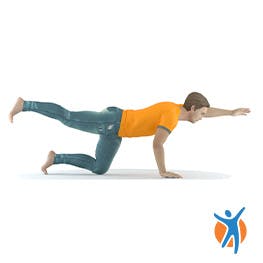
Bird Dog
Standing on all fours, reach away from your body with your opposite arm and leg whilst engaging your muscles in the standing limbs and stomach. Hold this position for a second before bringing the limbs slowly back down to rest. Do the same, with the opposing arm/leg. Repeat this sequence.

Shoulder extensions
Hold an exercise band in front of you at shoulder height. Stretch the band across your chest, bending your arms slightly. Ensure to keep your shoulder blades engaged and pulling down your back so your shoulders don’t hunch. Return to starting position, and repeat.
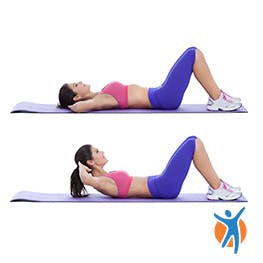
Crunches
Lie on your back with your knees bent and feet planted firmly on the floor. Cross your arms over your chest or place them gently behind your head for support. Keeping your neck straight and in alignment with your back, lift your shoulders up off the floor and then back down in a controlled manner. Repeat.
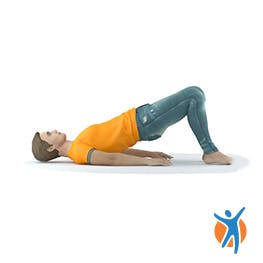
Bridges
Lie on your back with your knees bent, your feet hip width apart, and your arms flat on the ground almost touching your ankles. Push your hips up into the air, by squeezing your buttocks together. Use the support of your arms on the floor to avoid any pressure on the lower back, and keep your legs in-line with your body. Hold this position for a second before lowering.
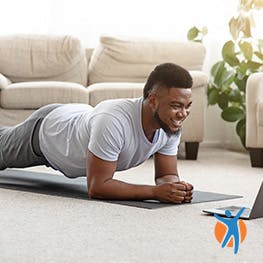
Planks
Get into plank position – forearms on the floor, with your elbows positioned directly under your shoulders and toes on the floor (a little like you’re about to do a push up, but on your forearms). Keep your back straight without letting your hips sag towards the floor. Hold for 30 seconds. Rest. Repeat.

Neck extensions
Sit comfortably with your shoulders back. Clasp your hands gently behind your head. Press your head firmly backward into your hands. Hold for 30 seconds and release. Perform multiple times to build strength. You can also vary this by moving your head side to side, or up and down, slowly, pausing and slightly stretching at the end of the movement arc.
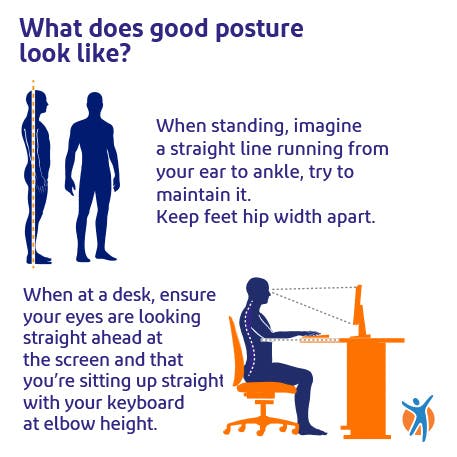
2. Pay attention to your desk setup
Adjusting how you sit at your desk can help improve your posture. Stooped posture is often a result of hunching over to look at a computer screen or mobile phone. Set up a home office where your screen is eye-level so you’re not looking down all day. Your hands and keyboard should be at elbow height, and your chair should encourage you to sit up straight and support your lower back.
All this is easier said than done, but if it looks like you’ll be working from home longer term, investing in a keyboard, mouse, and chair, could help your body cope with all that sitting down in the long run. And that brings us to…
3. Sit well
Channel your teacher telling you to stop slouching! Here’s how to sit properly. Sit with your back straight and shoulders back. Both feet should be firmly planted on the floor and your knees kept at a 90-degree angle. Your weight should be evenly distributed on both hips.
4. Lift well
When lifting objects, keep your back straight and bend at your knees and hips. Never bend forward at the waist to pick heavy objects up. Another tenet of lifting well is to keep the object in question as close to your body as possible. This can mean sliding an object to the edge of a table before lifting it, or standing close to an object on the ground that you’re about to lift. Make sure your feet are firmly planted and at a shoulder-width stance when you pick things up.
5. Sleep well
Select a mattress with proper support. Pick pillows that keep your neck in neutral alignment with your back when you sleep. Avoid falling asleep on the couch for the night. This can leave you with a crick in your neck or back. Instead, head to bed for a night’s rest that will have you moving freely and happily in the morning.
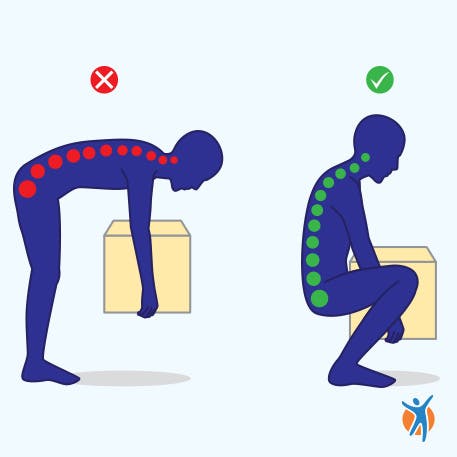
With improved posture and a stronger core, you’ll be helping hold your body in a way that isn’t so likely to induce back pain.
If you’re experiencing an aching back from sore muscles or ligaments, Voltarol 2% gel can help you get back on your feet. With a potent anti-inflammatory ingredient it fights pain, reduces inflammation, and accelerates your recovery, so you can get back to doing what’s important (like picking up that toddler with more ease!).
Treatment by pain type
Learn all about the causes, symptoms, and pain treatments for the type of pain you’re experiencing so you can get back to doing those little things that bring you joy.












